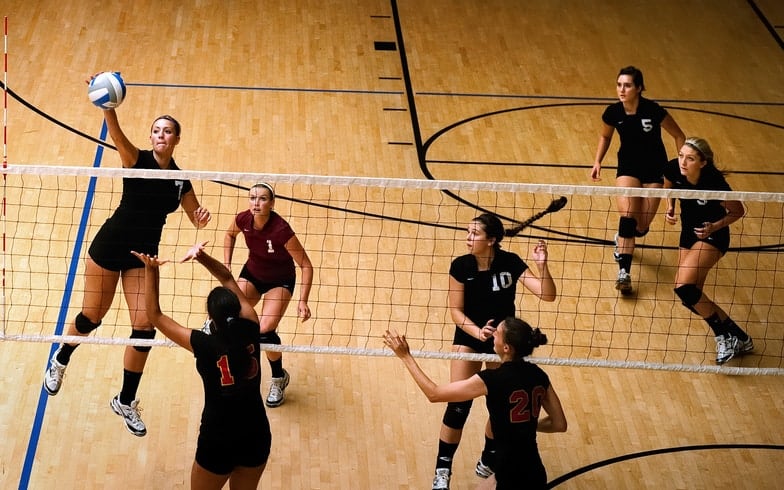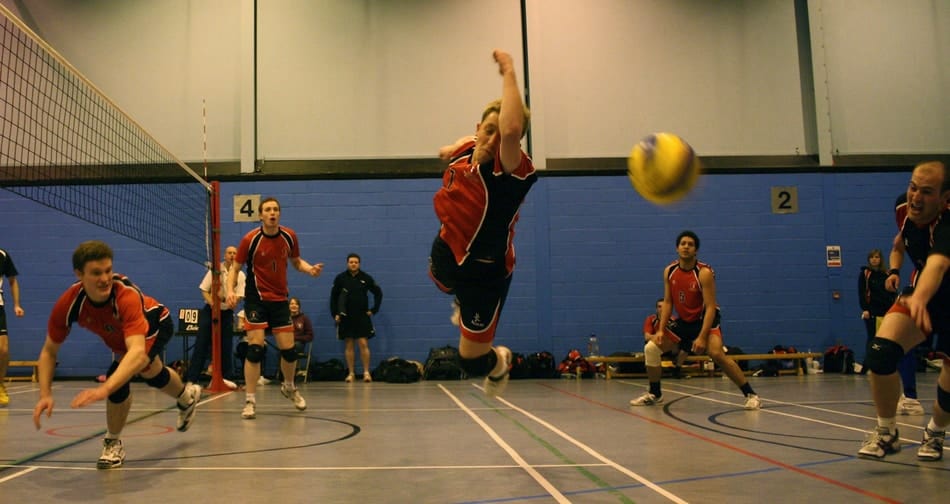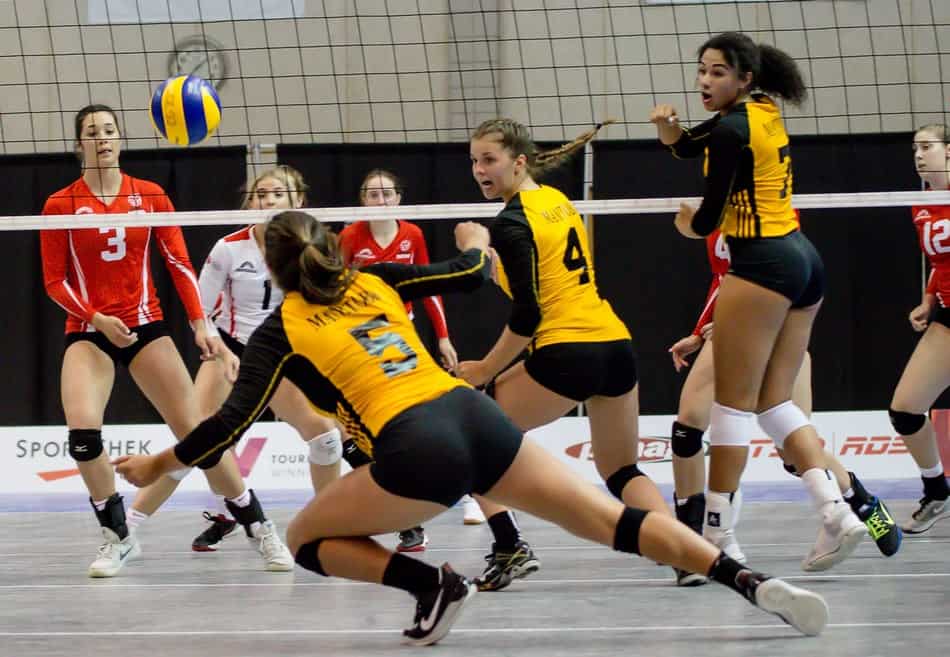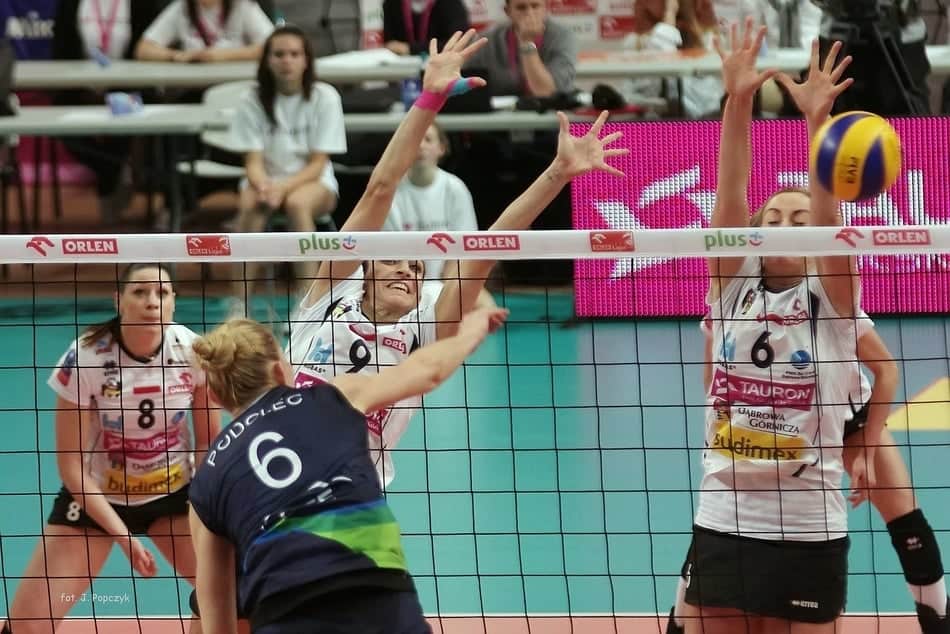Volleyball has grown in popularity over the years and is played all over the world in various forms. There is the standard volleyball that we see played in a gymnasium, sand volleyball that we see in the Summer Olympics, and the lesser-known version of snow volleyball. But did you know that there are some pretty strict rules and regulations governing the game? It is easy to get lost when trying to read through them.

That is why we came up with Volleyball Rules: An Easy-To-Follow Guide to help clear up some of the confusing language of the official guide. We aren’t leaving anything out; we are just making everything a little bit clearer.
Starting with facility guidelines and working our way through what is expected of players and uniforms, we’re giving a simple overview of everything you need to know to understand the game. This guide is most suited for the standard gymnasium volleyball and not the other two versions. There are some similarities between the types of volleyball, but they are different. So, let’s get started learning the rules and guidelines of volleyball.
Facility and Equipment Guidelines
Knowing what facilities and equipment are permitted and the standards that govern an official playing area is important if you are playing an official game. If you’re playing a fun “backyard” game of volleyball, don’t feel like you have to follow each and every rule.
- Playing Area is defined by the area in which the game happens. There are regulations and rules for this area and defined dimensions. The playing area also includes a free zone outside the boundaries of the court, in which the players can still make a play on the ball before it hits the ground. The typical playing area is a symmetrical rectangle. A basketball court is a typical place for a game to take place since it is roughly the same size required when you include the free zone around the court lines. The play area should be flat unless it is outside, where it may have an incline for drainage.
- Net and Posts are important parts of the game and do have regulations on them. A net should be close to 8 feet high (2.43 meters) for the men’s league and around 7’4” (or 2.24 meters) for the women’s league. The measurements are strictly enforced. The posts for the nets are placed anywhere between 1 ½ feet (0.5 meters) and 3 ½ feet (1 meter) outside of the sidelines to offer plenty of extra surface area.
- Balls have to be the regulation size, and all balls used in a game must be uniform. The standard size of a volleyball is between 65-67 cm in circumference and 260-280 grams in weight.
Would you like to find our recommended equipment for volleyball officials? Check out our Officials Equipment page.
Volleyball Teams and Players
While all of the regulations about the facility and the balls used are very important for an official game, the players and the makeup of the team are even more important. Without the appropriate team structure and rules to govern what they do and wear, there is no game!
- Team Makeup. A team can have up to 12 players, coaching staff, and possibly a medical team depending on the level of play. Middle and high school teams may not have medical staff, but college and professional teams will definitely have medical staff. Players have to be listed on the score sheet that’s given to the ref before the set begins to play in that particular game.
- Location of the Players. If the players are not in play, then they must be on the bench or in the bench area. They can do limited warmups outside of their free zone, but typically they need to stay in the bench area. There are times in which players can warm up with balls, but these are designated intervals and will not be while the game is going on. It is traditional in many levels of volleyball for no one to actually sit on the bench, everyone stands. As long as they are within the boundaries of the bench area, and aren’t interfering with the game, this is fine.
- Equipment and Uniforms. The player’s equipment consists of their uniform and their sports shoes. Knee pads, elbow pads, and similar protective gear is optional. The jerseys should be numbered 1-20, and you may notice the team captain will have a line under their number on the front of the jersey. The uniforms all have to match with the exception of the libero whose uniform must look strikingly different and is usually reverse colors from the rest of the team. Change of Uniforms is only allowed under certain circumstances and must be approved by the official. This includes playing barefoot, changing out of dirty or damaged uniforms, or playing in warm-up suits in cold conditions.
- Items that are not allowed. There are items that are not allowed on the court. The official can require them to be removed or have a player sit out. An object that may cause injury to any player or give someone an unfair advantage is not allowed. A common example would be jewelry that a player forgets to remove. Players can wear protective pads and glasses or sports goggles, however.
- Leaders of the Team have to be determined before a game. This includes captains, coaches, and assistant coaches.
Volleyball Scoring and Winning
Now for the most important part of any competitive sporting event, how to score and win! Knowing how to actually make a point and what constitutes a win of a set and a match is imperative to the game. Players, coaches, and spectators really need to know this information to compete at a high level.
Would you like to shop for our favorite recommended player products? Choose the item below and click to shop on Amazon.
How to Score
There are actually a few ways that a team can get a point in the game of volleyball. The most common way to score a point is by landing the ball on the floor or ground of the opponent’s side of the court. However, don’t think that’s the only way! If the opponent commits a fault or receives a penalty, then the other team receives a point.

A fault is anything that goes against the rules of the game. Every rally, every time the ref blows the whistle and motions for the player to serve, that play is worth a point. Even if the ball is never served, if someone broke a rule, a point will be awarded to someone.
The only exception to this would be if there is a replay. If play needs to be stopped mid-rally for some reason, the ref will signal a re-do and the score will not change and the same player will re-serve. The most common reason for this is when another ball from outside the game enters the playing area, play is immediately stopped for the safety of the players.
How to Win the Game
Scoring points is pretty important when it comes to winning a volleyball game, but what is required to actually win a set and a match? A volleyball match is made up of multiple sets, so your team has to win the majority of sets. The number of sets will depend on the level of play and whether it is a regular-season game, an exhibition game, or a tournament.
A Set in Volleyball
Winning a set means that you have reached the predetermined number of points first. Typically, that number of points is 25 in order to win. For tie-breaker matches, the total is reduced to 15. However, you have to get this point total with a minimum lead of two points.
If there happens to be a 24-24 tie, then the game will continue until there is a two-point lead.
To learn more about the rally scoring system in volleyball, take a look at our post called: Rally Scoring In Volleyball Explained
A Match in Volleyball
In order to win a match, you have to win the majority of the sets. Tie-breaker sets happen when each of the teams wins an equal amount and is going into the final set in a tie. So whether it’s a 1-1 tie, or a 2-2 tie, then the last set is played to 15 points to decide the match-winner.
Default and Incomplete Team
This is basically a forfeit. If a team is scheduled to play but doesn’t show up on time, then they lose by default. This is true also for a team that does not have enough players, a team must have at least 6 players to qualify. A team that is incomplete cannot play and must lose the game by forfeit.
Play Structure
The way the game is played is also important. This structure is made up of how the players line up, the positions they play, the rotation they take, and the mechanics of how the game is started. There are specific ways that all of these things work.
The Coin Toss
If you are familiar with other sports, then this may be a familiar concept. This is slightly different in volleyball, however. The toss happens to decide two different factors. Before the warmup happens, the first referee does a toss and the team who wins the toss may choose to serve first or choose which side of the court their team will possess.
Whichever team loses the toss will have the choice of the other question. So for example, team A wins the toss and chooses to serve first. Then the referee would ask Team B which side of the court they would like to have first.
In each set following, the teams will alternate sides and alternate getting to serve first. The reason for alternating sides is to remove any advantage in case there may be one side that is perceived to be better for whatever reason. Halfway through the tie-breaker set, the referee will signal for the teams to switch sides again.
The Warm Up
There are a few different options for warmups. If the teams have already had the opportunity to separately warm-up before the official warmup time, then there are a collective six minutes allowed to warm up on the court together.
If neither team has had a warmup, then 10 minutes will be allowed for the teams to practice together. The team captains do have the right to request separate warmups for their team, but if they do that, then the warmup times are cut in half.
The Starting Lineup
There must be a starting lineup of six players presented by each coach prior to the start of the game. This lineup will determine the rotation of the players for the remainder of the match. The libero will not be included in the original lineup and may replace another player on the court immediately after the referee has verified that the players are lined up correctly.
The Positions
With the six players on the court, they must begin each rally in their rotational positions. The positions are numbers and players may receive penalties if they are not in their correct position order when the ref signals the beginning of the next rally. There are three players that are positioned in the frontcourt, near the net, and are position numbers 4, 3, and 2 placed left to right if you’re looking at the net.
The back row also has three players that have to be further from the centerline than the player in front of them and they are also numbered. Their sequence is 5, 6, and 1 numbered left to right, again if you’re facing the net.
After each rally that your team wins a new possession of the serve, everyone on your team will rotate to the next position in a clockwise direction.
For an in-depth look at volleyball positions, read Understanding the Positions in Volleyball
Positional Faults
Positional faults can happen in a few ways. The first situation is if service starts and the players on either team are out of their positions. Another way is if there is an illegal substitution that is not caught before play resumes.
One of two things will happen if there is a positional fault. The players will be sanctioned, and there is a point to the other team as well as service is shifted to the other team. Or they can just be required to fix the problem with no other consequences at the referee’s discretion.
The Rotation
Rotation happens every time the play is won by the receiving team. The team has to rotate clockwise and change positions.
The rotation order is set by the starting lineup and must be followed. When a substitute player comes into the game, they will assume the position of the person they are replacing and they must keep that position.
Rotational Faults
Rotational fault happens when a team fails to rotate appropriately or not at all. If you fail to rotate and service starts, then you could cost your team a point and the right to serve.
The offending team could also just be asked to fix the mistake without costing them a point. If a rally happens before the mistake is caught, the other team can only receive one point regardless of the rally outcome.
Rotation can be confusing, learn all about it in: The 8 Parts To Understanding Rotation In Volleyball
Playing the Ball
Is there really anything in volleyball that is more important than actually playing the ball? All of the other rules and aspects of the game work together to make the game flow properly and come out with fair results. But if you don’t play the ball, then no one can actually win!
There are rules and regulations for hits as well, and if they are violated, then it will cost your team points. So you need to know what you can and cannot do when it comes time to hit.
Team Hits
There are 2 main rules and 1 exception when it comes to the number of hits for your team:
- A total of three hits may be played on the ball by a team before it has to cross the net.
- A single player is not allowed to hit the ball twice consecutively.
The exception with both of these rules is that a block does not count as a hit in indoor volleyball. So a player who blocks the ball may immediately hit the ball again, and a team who blocks the ball has 3 more hits to get the ball back over the net.
What is a Hit?
A hit is basically anytime the ball comes in contact with the body. Throughout most of the articles on this website, you’ll read it being called a “contact.” Typically, this is done with hands and forearms, but can technically be done with any part of the body. The ball cannot be caught or thrown, it has to be hit.

Faults in Playing the Ball
There are faults when it comes to playing the ball. If the team hits the ball more than three times before it is returned to the opponent, then they have committed a fault and give the other team a point. This is also true if a single player hits the ball twice in a row.
Another type of fault is if the ball is caught or thrown by any of the players. This will also give the other team a point. They also cannot take assistance from another object or teammate to hit the ball. That is considered a fault.
There are also illegal hits when you lift the ball or swipe it through the air instead of hitting it. If you touch the net while trying to play the ball, that will also count as a fault.
In each of these cases, if your team commits the fault that means your team loses the rally and the other team gets a point and the next serve.
Type of Hits
There are several different types of hits in the game of volleyball and knowing what they are will help you improve not only your knowledge of the game but also the way you play.
Volleyball Service
Service is when the person in the first position on the court sends the ball to the opponent and starts the game or rally. This is typically done from the right-back corner of the court but is actually legal from anywhere behind the end line.
Players have to follow the order of rotation to determine the service order. Whether players are good or bad at serving, each rotational position must take their turn at serving.
Learn more about serving in this article: Mastering the 4 Types of Serves in Volleyball
Volleyball Passes
It is perfectly normal and actually recommended that players “pass” the ball to their teammates when they are receiving the ball instead of playing it directly back to their opponents.
Passes are usually hits that use both hands or both arms simultaneously to deliver the ball in a controlled way to the intended teammate. If passing with a “volley”, also called an overhand finger pass, players need to use a quick, fluid motion and keep from catching and throwing the ball.
Volleyball Attacks
If you are sending the ball aggressively to the opponent, but it isn’t the service, then you are using an attack. This is really any time after service that a team is attempting to score a point. All contact with the ball during an attack play has to be made in a player’s own playing space. Contact with the ball cannot happen on the opponent’s side of the net.
Volleyball Blocks
Players that are positioned close to the net can use this play. This is an attempt to stop the other team from scoring and sending the ball back over the net. Often a block that is executed appropriately will result in the blocking team receiving a point.

However, the blocking team cannot interfere with the ball on the opponent’s side of the net. They can reach across and try to deflect the ball as soon as it’s been struck by their opponent.
Can a Player Touch the Net?
A player is really not permitted to come into contact with the net, this is considered a fault. There are some rare cases where, if the contact is incidental, away from the action and the ref deems it irrelevant, it may be overlooked.
Players can, however, cross the space above or below the net with their feet or hands as long as it doesn’t cause issues with the game or interfere with the other team. This is permitted as long as the contact with the ball happened on their side of the net.
They cannot cross the net to keep the opponent from completing a play. This is against the rules and they will likely be called, which means they will give the other team a point.
Types of Game Interruptions
There are interruptions that are permitted to happen during a game. Some of them are normal interruptions that are expected with any game, while others may only happen once in a while or not at all.
Regular Interruptions
Regular interruptions are just as they sound. Normal, regular parts of the game that will allow teams to change our players or regroup and strategize play. Examples of these types of interruptions are:
- Timeouts are limited to two requests per set.
- Substitutions are also limited, but a team can have up to six per set.
Delays
Delaying the game means that you do something you know you shouldn’t do to buy time or rest for your team. Taking more time during your legal timeout is delaying the game as well as anytime you ask for an illegal timeout, illegal substitution, or continue to make an improper request. Each of these may be called a violation by the ref, awarding a point to the opposing team.
There are, however, interruptions that can be considered exceptional because they don’t happen often. These are not considered delaying, and special provisions are made for them. This can be injuries, illness, bad weather, power outages, or anything that would interrupt the normal play.
The Officials in Volleyball
The officials that govern the game in volleyball are called referees and line judges. There will be an “up ref” which is the 1st referee that stands above the game on a stand or pedestal. There will also be a “down ref” which is the second referee.
There will be either 2 or 4 line judges to assist the referees in calling the game. If there are only 2, they will be on opposing corners, both on the left side of their end line.
You can learn all about the roles and rules for the referees in our post called: Volleyball Officials: Meet The Refs.
Volleyball Really Is a Great Sport
I hope that you’ve found this summary of the rules helpful. This doesn’t cover every detail, but it’s meant to help give a good overview.
For more specific questions, feel free to use the search function at the top right of the page to find other articles that dive specifically into more narrow topics.
Photo Credits:
Featured image by Hans Splinter on flickr.com: https://creativecommons.org/licenses/by-nd/2.0/
Two black teams image by Tucker Hammerstrom on flickr.com: https://creativecommons.org/licenses/by-nd/2.0/
Epic diving image by wee mickey on flickr.com: https://creativecommons.org/licenses/by/2.0/
Player #5 diving image by 2017 Canada Summer Games on flickr.com: https://creativecommons.org/licenses/by/2.0/
Blocking image by Jaroslaw Popczyk on flickr.com: https://creativecommons.org/licenses/by/2.0/
Recent Posts
Athletes, listen up! Do you have a closet full of old jerseys, sweatpants, and tees that you just can't seem to part with? Well, dust them off, because you're sitting on a goldmine of fashion...
You may have heard, or you may have noticed, that there's been a change to the rule about double contact in volleyball. In 2022, an experimental rule change began to be implemented, where the double...
